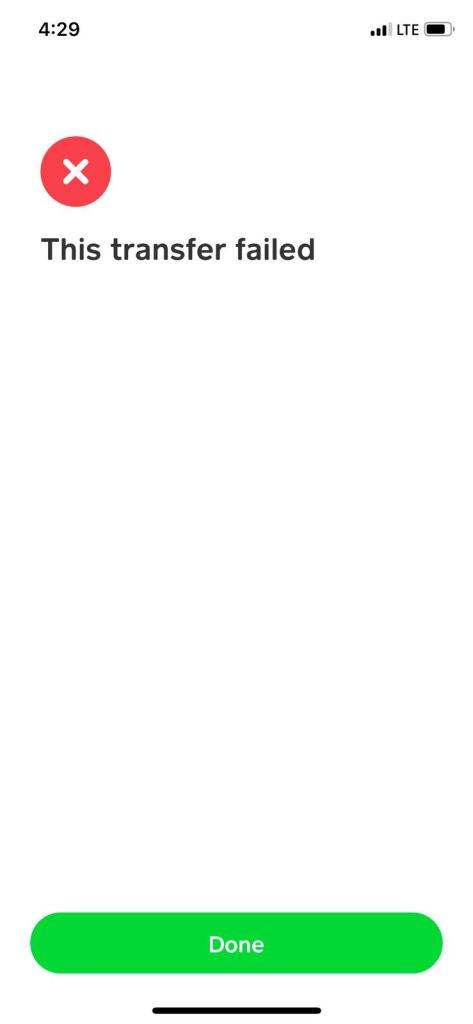Cash App is a popular peer to-peer payment app that allows users to send and receive money quickly and easily. However, sometimes Cash App transfers can fail for a variety of reasons. This can be frustrating and leave users wondering what went wrong and how to fix the problem.
In this blog post, we will explore some of the common causes of Cash App transfer failures and provide some tips on how to resolve them. Whether you’re a seasoned Cash App user or new to the platform, this post will help you understand why your transfer may have failed and how to get your money moving again.
Why Cash App Transfer Failed?

There can be several reasons a Cash App transfer might fail. Some common causes include:
- Insufficient funds: If you don’t have enough money in your Cash App account or linked bank account, your transfer will fail.
- Incorrect recipient information: If you’ve entered the wrong email address, phone number, or $Cashtag (a unique identifier used on Cash App), your transfer will fail.
- Payment declined: Your transfer may be declined if you’ve reached your sending or receiving limit, or if you have a negative balance in your account.
- Technical issues: Sometimes, Cash App experiences technical issues that can cause transfers to fail. This can be because of server outages or other issues beyond your control.
- Invalid card: If you’re using a debit or credit card to make a payment, it may be declined if it’s expired, has insufficient funds, or if it’s been reported as lost or stolen.
- Bank account not set up: If you’re trying to transfer money from your bank account to your Cash App account, it may fail if your bank account isn’t properly linked to your Cash App account.
- Payment blocked: In some cases, Cash App may block a payment for security reasons or to protect you from fraud.
Why Does Cash App Say The Transfer Failed For My Protection?
Cash App is the most secure way to send and receive money. For your protection, Cash App will may not allow you to transfer bulk money to a new Cash App account or suspicious account.
Cash App will always let you know if they detect suspicious activity on your account and provide full refunds within 24 hours if fraud occurs.
Transfer From Your Debit Card Has Failed On Cash App; What Should I Do?
If you’re having trouble transferring money from your debit card to Cash App, make sure you have a sufficient fund in your card, make sure your card is acceptable. If the issue persists, you may need to try again later, use another transfer method or contact Cash App on their website for help.
How To Stop Cash App From Canceling Payments
There are a few steps you can take to try and prevent Cash App from canceling your payment:
1. Make sure you have enough funds in your account.
This is the most obvious reason why a Cash App payment might be canceled. If you don’t have enough money in your account to cover the payment, Cash App will cancel it. To avoid this, make sure you have enough money in your account before you send a payment.
2. Verify your account.
Cash App may also cancels payments if the recipient’s account is not verified. To verify your account, you will need to provide your full name, date of birth, and Social Security number. You can also verify your account by linking a bank account or debit card.
3. Avoid sending payments to unfamiliar or unverified recipients.
Cash App is a great way to send money to friends and family, but it’s important to be careful when sending money to unfamiliar or unverified recipients. If you’re not sure if someone is who they say they are, it’s best to avoid sending them money.
4. Make sure you have a strong and stable internet connection.
Cash App payments can also be canceled if you don’t have a strong and stable internet connection. If you’re having trouble sending a payment, make sure you’re connected to a strong Wi-Fi network or have a good cellular signal.
5. Check the recipient’s Cashtag or phone number before sending a payment.
When you send a payment through Cash App, you need to enter the recipient’s Cashtag or phone number. If you enter the wrong Cashtag or phone number, Cash App may cancel the payment.
6. Use Cash App frequently.
The more you use Cash App, the more likely it is that your payments will be processed without being canceled. This is because Cash App uses your transaction history to assess your risk of fraud.
5. Contact Cash App support if you need help.
If you’ve tried all of the above and your Cash App payments are still being canceled, you can contact Cash App support for help. They may be able to help you identify the problem and resolve it.
Conclusion
Cash App transfer failures can occur for a variety of reasons, including insufficient funds, incorrect recipient information, etc. If you experience a failed transfer on Cash App, follow the troubleshooting tips in this article to resolve the issue.
If the problem persists, you may need to contact Cash App customer support for further help.
John Gurche was born in Los Angeles, California, and raised in Utah, England, New York, and Los Angeles again. He attended the University of California, Santa Barbara, earning his BA in 1969, and his Ph.D. in 1975. He is the author of 10 books, including: A History of Western Philosophy (with Stephen Toulmin), The Moral Landscape: How Science Can Determine Human Values, and The Liberal Imagination.

